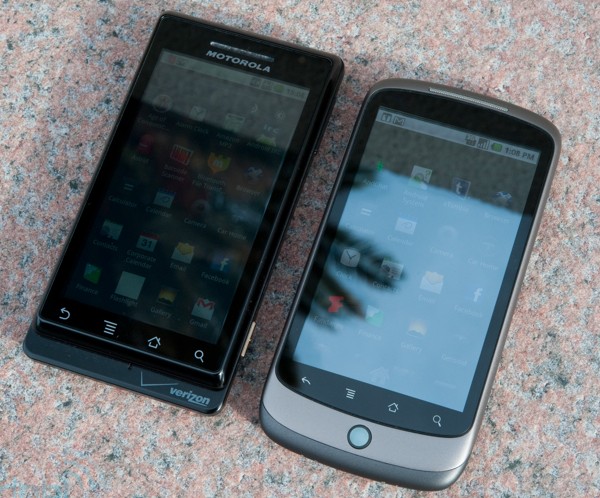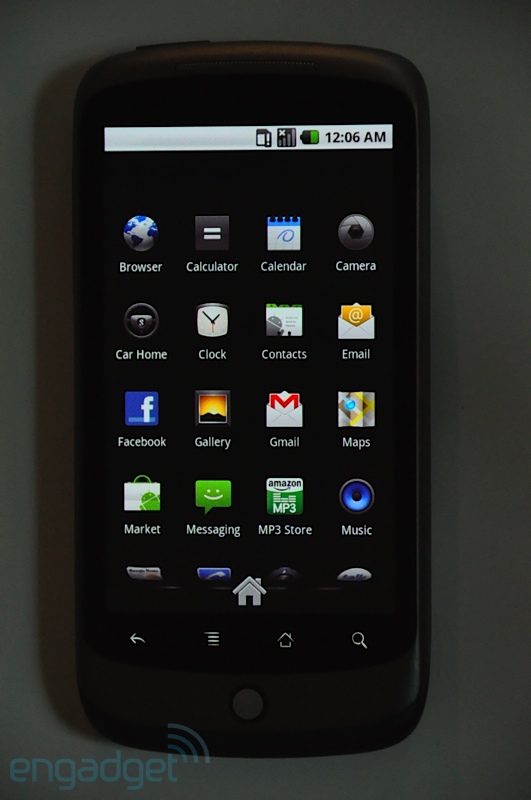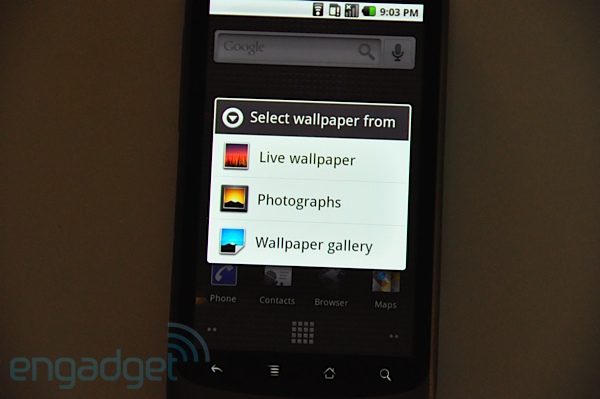Google Nexus One Review

The guys from Engadget, who attended the Consumer Electronics Show, held in their hands, perhaps, the hottest novelty of the event - the Google Nexus One smartphone. I bring to your attention his review, as they say, in hot pursuit.
In terms of intensity, rumors about a hypothetical phone from Google could only compete with an Apple tablet. Now that the curtain of rumors has been lifted, we have a really extremely interesting device. I have already cited the detailed characteristics of the new product from the official Google site, but what is it in a subjective sense?
Design

The manufacturer of the Nexus One is, if someone does not know, the Taiwanese HTC. Taiwanese have tried their best: the device looks stylish, expensive, much more interesting than the first guglofon T-Mobile G1. Forms are soft, inconspicuous, without stressed “masculinity”, but not too feminine. So you hear how people from Google beg HTC: “Make us something as stylish as the iPhone, but with your face!”
We can say that the task is completed: the smartphone really looks original, you can’t call it an absolute clone of the iPhone. It is guessed and something from HTC, and something from Google. The body consists of two elements: the main panel is dark gray, it passes through the back and is quite soft to the touch. The second is lighter, but also more solid, metallic, it borders the screen. The smartphone is very thin for its impressive performance - only 11.5 mm . Color is a mixed feeling: not everyone likes the gray-brown palette. It is still unknown whether Google is going to offer other colors. However, I think that I will be right if I say that the Nexus One is in any case hardly inferior in terms of design of the iPhone, Pre or Droid.
Hardware

The heart of the smartphone is a fairly powerful gigahertz chip Quallcomm Snapdragon , memory - 512 MB and operational, and built-in. The filling is such that the head can go round: what are only three types of sensors (light, proximity and accelerometer). There are GSM (AWS and European 2100 MHz), Wi-Fi , AGPS , a slot for microSD cards , and the bundle includes a 4 GB card, and the maximum capacity can be 32 GB. In general, the phone is fast, but there is no fundamental difference with the Motorola Droid.
The 3.7 inch AMOLED display is very good. In terms of sensitivity, it does not differ from other guglofonov. The resolution is 480 × 800 , which is quite a lot, but this is 54 pixels less than that of the Droid (480 × 854). Not everything is in order and in the color rendition: red and orange shades look somewhat exposed, more brightly than on the computer monitor, which is clearly visible on the web pages. However, it often happens on AMOLED-screens. In bright light, the screen can be seen frankly bad, here Google didn’t make a revolution with HTC.
Unlike the Droid, the Nexus One trackball is located under the keys, which may seem a little inconvenient, but Hero users are well aware of this arrangement. On the left side there is a joystick to adjust the sound. Above - the button to turn on, it also activates and deactivates the standby mode. On the other hand, there is an audio jack of 3.5 mm, next to it is a microUSB port , a microphone hole and some other connector, the purpose of which at a glance is difficult to determine. On the back of the smartphone are, as expected, the camera and flash.

Yes, another important point: the display in the Nexus One is not multitouch! Those who are accustomed to the iPhone and other multi-touch devices, to their original gestures and funny games, it will be hard to adapt to the Nexus One. Because of this, some programs do not work, for example, the NESoid NES emulator. Quite a strange step by Google, given the close competition with the iPhone.
Camera

Let me remind you that the Nexus One camera is a 5 megapixel sensor, LED flash , video at 720 × 480 at a speed of 20 frames per second . The speed of the camera is very decent, the quality of the pictures is also at the level: they are detailed and without the chronic problems for HTC, typical of other models. Focusing works incredibly fast.
Google did the right thing improving the Gallery app. The new version almost does not feel the dull legacy of the first models, now it is a very nice and friendly application with a large number of options, such as panoramas and slideshows.
A few more shots:
i.miniblog-tech.ru.s3.amazonaws.com/wp-content/uploads/2010/01/nexus_shot_main1.jpg
i.miniblog-tech.ru.s3.amazonaws.com/wp-content/uploads/2010/01/nexus_pics51.jpg
i.miniblog-tech.ru.s3.amazonaws.com/wp-content/uploads/2010/01/nexus_pics81.jpg
i.miniblog-tech.ru.s3.amazonaws.com/wp-content/uploads/2010/01/nexus_pics61.jpg
i.miniblog-tech.ru.s3.amazonaws.com/wp-content/uploads/2010/01/nexus_pics21.jpg
')
Telephony
As a phone, the Nexus One is not fundamentally different from most GSM models. The sound is quite loud, the reception is quite good, the interlocutor is heard well. However, Motorola Droid sound quality when talking higher.
In terms of 3G reception, the Nexus One is as good as the iPhone, but both of them lose to phones from Verizon, in particular, to the same Droid. For example, at the John F. Kennedy airport, testers could not talk either on the Nexus One or on the iPhone, and the Droid worked perfectly. Perhaps the problem is in the operator: Nexus One was tested on AT & T. In Las Vegas itself, where the exhibition was held, all three phones worked on 3G the same way. The average download speed for 3G data in the Las Vegas area was 559 Kbps: quite an expected and quite good result.
Software

The operating system is the latest Android 2.1 , partially upgraded in the depths of Google. In these upgrades lie the most interesting moments. Many even thought that for the first time we would see a “real Android”, true to the true spirit of Google, while all the other Google phones didn’t fully correspond to this spirit.
The reality was more prosaic. Essentially, Android 2.1 is not much different from version 2.0.1, on which the Motorola Droid is currently running. Google’s signature touches are so subtle that it surprised even many. I will mention some of them.
First, it is navigation in the home screen . Apparently, Google did work on the bugs and took into account numerous complaints regarding the home screen. The situation with him was really not pleasant. In 2.1, the paradigm of navigation in the bowels of the smartphone is somewhat changed. Google completely refused to leave the box, which was previously stored application icons. Now, instead of it, a simple house icon with which you can access application icons from any screen: they approach the user, after which they can be scrolled with fun three-dimensional animation.
Further, Google increased the number of available home screens from three to five (apparently following the example of Sense and BLUR). The result was a cross between an iPhone and webOS. Understand where you are, help special points. With a long press on the point, a kind of card with miniatures of all home screens comes out, which you can immediately go to:

It's nice that Google cares about the first impression that the user receives from the device, seeks to make it extremely friendly and easy to learn. Although these changes are essentially cosmetic, they successfully solve a number of problems that the platform has suffered from before.
But the problems remained. Outdated and overweight music player has not changed much. Although the virtual keyboard is better than in previous models, it still suffers from inaccuracy. And then Google decided to surprise us: on the Nexus One there is a fundamentally new text input method, unseen before on Android, - voice . However, it works with varying success. While this technology, to be honest, is damp.
Some results
Nexus One is a good smartphone, it’s indisputable, but it’s not a milestone, a new era, etc., as many people have been saying before it appeared. This is a good Android smartphone with advanced hardware, but it has no obvious advantages over the Motorola Droid. Of course, if Google wants to engage in popularization of the platform, then this is the right device at the right time: the leading processor, the excellent screen, the elegant design, the exotic functions such as the proximity sensor. It has everything that is called a geek effect. On the other hand, the lack of a multi-touch display is clearly perplexing.
In the US, the Nexus One will sell for $ 529.99 . If the Russian price does not change significantly, then almost certainly it will be sold to us much better than the iPhone.
Translation by Engadget .
Source: https://habr.com/ru/post/80233/
All Articles